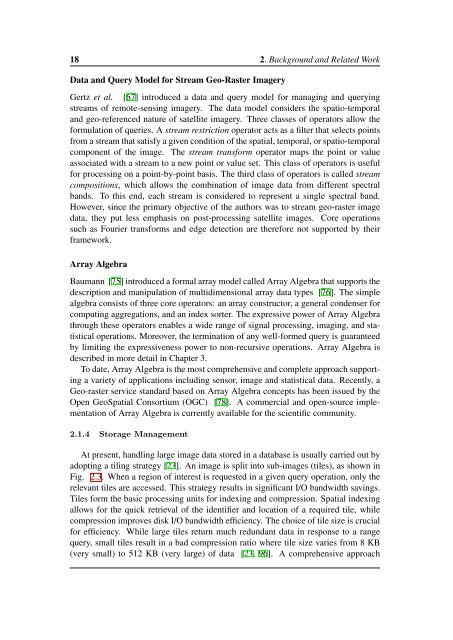Applying OLAP Pre-Aggregation Techniques to ... - Jacobs University
Applying OLAP Pre-Aggregation Techniques to ... - Jacobs University
Applying OLAP Pre-Aggregation Techniques to ... - Jacobs University
Create successful ePaper yourself
Turn your PDF publications into a flip-book with our unique Google optimized e-Paper software.
18 2. Background and Related Work<br />
Data and Query Model for Stream Geo-Raster Imagery<br />
Gertz et al. [67] introduced a data and query model for managing and querying<br />
streams of remote-sensing imagery. The data model considers the spatio-temporal<br />
and geo-referenced nature of satellite imagery. Three classes of opera<strong>to</strong>rs allow the<br />
formulation of queries. A stream restriction opera<strong>to</strong>r acts as a filter that selects points<br />
from a stream that satisfy a given condition of the spatial, temporal, or spatio-temporal<br />
component of the image. The stream transform opera<strong>to</strong>r maps the point or value<br />
associated with a stream <strong>to</strong> a new point or value set. This class of opera<strong>to</strong>rs is useful<br />
for processing on a point-by-point basis. The third class of opera<strong>to</strong>rs is called stream<br />
compositions, which allows the combination of image data from different spectral<br />
bands. To this end, each stream is considered <strong>to</strong> represent a single spectral band.<br />
However, since the primary objective of the authors was <strong>to</strong> stream geo-raster image<br />
data, they put less emphasis on post-processing satellite images. Core operations<br />
such as Fourier transforms and edge detection are therefore not supported by their<br />
framework.<br />
Array Algebra<br />
Baumann [75] introduced a formal array model called Array Algebra that supports the<br />
description and manipulation of multidimensional array data types [76]. The simple<br />
algebra consists of three core opera<strong>to</strong>rs: an array construc<strong>to</strong>r, a general condenser for<br />
computing aggregations, and an index sorter. The expressive power of Array Algebra<br />
through these opera<strong>to</strong>rs enables a wide range of signal processing, imaging, and statistical<br />
operations. Moreover, the termination of any well-formed query is guaranteed<br />
by limiting the expressiveness power <strong>to</strong> non-recursive operations. Array Algebra is<br />
described in more detail in Chapter 3.<br />
To date, Array Algebra is the most comprehensive and complete approach supporting<br />
a variety of applications including sensor, image and statistical data. Recently, a<br />
Geo-raster service standard based on Array Algebra concepts has been issued by the<br />
Open GeoSpatial Consortium (OGC) [78]. A commercial and open-source implementation<br />
of Array Algebra is currently available for the scientific community.<br />
2.1.4 S<strong>to</strong>rage Management<br />
At present, handling large image data s<strong>to</strong>red in a database is usually carried out by<br />
adopting a tiling strategy [23]. An image is split in<strong>to</strong> sub-images (tiles), as shown in<br />
Fig. 2.3. When a region of interest is requested in a given query operation, only the<br />
relevant tiles are accessed. This strategy results in significant I/O bandwidth savings.<br />
Tiles form the basic processing units for indexing and compression. Spatial indexing<br />
allows for the quick retrieval of the identifier and location of a required tile, while<br />
compression improves disk I/O bandwidth efficiency. The choice of tile size is crucial<br />
for efficiency. While large tiles return much redundant data in response <strong>to</strong> a range<br />
query, small tiles result in a bad compression ratio where tile size varies from 8 KB<br />
(very small) <strong>to</strong> 512 KB (very large) of data [23, 96]. A comprehensive approach
















